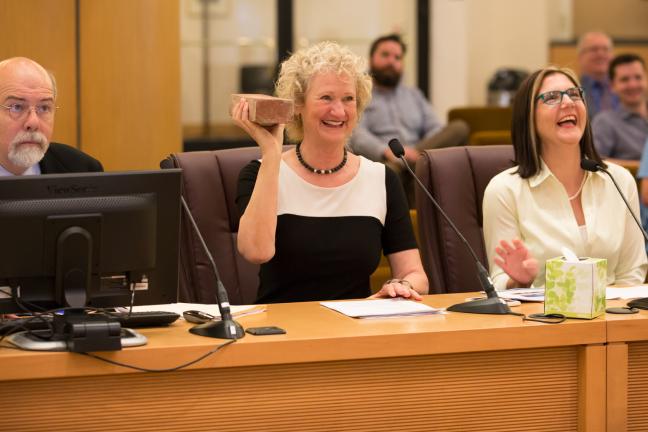Multnomah County got done in Salem what it set out to accomplish: secure funding for a new courthouse.
During the 2017 legislative session, which adjourned July 7, Multnomah County secured from the Oregon Legislature the final $92.6 million of the approximate $300 million needed to build a new central courthouse. The new 17-story, 44-courtroom building will replace the county’s downtown structure which does not meet current seismic codes.
“It’s been a heavy lift for the past four years,” Government Relations Director Claudia Black said of the county’s ongoing efforts to secure funding during a Board of Commissioners meeting Thursday, July 20.
At the meeting, the county’s government relations team also highlighted the county’s legislative wins of the 2017 session in health, equity and public safety issues. The team also highlighted statewide funding for justice reinvestment and the state’s $5.3 billion transportation package to tackle traffic congestion and fix and expand the state’s roads and bridges.
Here is a review of some of the county’s top legislative priorities:
HEALTH
Provider tax: The county supported a tax on health care providers intended to preserve Medicaid for the more than 375,000 Oregonians who enrolled in the Oregon Health Plan as part of Medicaid expansion. The tax helps to address the state’s budget deficit. About 82,000 people living in Multnomah County now have health coverage through expanded access to Medicaid. More than 80 percent of patients at the county’s Community Health Centers receive coverage through Medicaid.
On July 3, the Governor signed House Bill 2391 to raise taxes.
Tobacco 21: The county lobbied to increase tobacco purchasers’ age from 18 to 21 in an effort to reduce teen smoking rates. Senate Bill 754 A has been sent to the Governor’s Office and is awaiting signature.
“This is significantly going to reduce morbidity and mortality of generations of Oregonians,” Deputy Government Relations Director Rosa Klein said.
Opioids: For several years, the county has worked to reduce opioid overdose deaths in Multnomah County. During the legislative session, the county advocated for removing Naloxone training requirements to make it easier for people to use Naloxone to save lives; eliminating pre-authorization requirements for 30 days of treatment to allow doctors to get people suffering from addiction into treatment quickly; allowing clients on addiction treatment medication in drug court; and increasing oversight on opioid prescribing.
House Bill 3440, which addresses Naloxone availability and prescribing oversight, is in the Governor’s Office awaiting signature.
Cover All Kids: The county lobbied for Senate Bill 558 which provides healthcare to all Oregon children regardless of immigration status. The bill has been sent to the Governor’s Office and is awaiting signature.
Privacy rights for immigrant families: House Bill 3464 protects the privacy of immigrant families by prohibiting a public body in Oregon from disclosing certain information for the purpose of enforcement of federal immigration laws. The bill is in the Governor’s Office awaiting signature.
Reproductive rights: The county fought for advances in gender equity by supporting House Bill 3391 which says insurance plans must provide a full range of reproductive health services. The bill is in the Governor’s Office awaiting signature.
Gun safety: The county lobbied for extreme risk protection orders which allow family members or law enforcement to seek a court order to prohibit a person from possessing a deadly weapon when the court finds that person is a risk in the near future, including imminent risk of suicide or causing injury to another person.
Senate Bill 719 is in the Governor’s Office awaiting signature.
HOUSING
Shelter: The county supported additional money for funding shelter and emergency housing, which was increased by $20 million to a total of $40 million statewide.